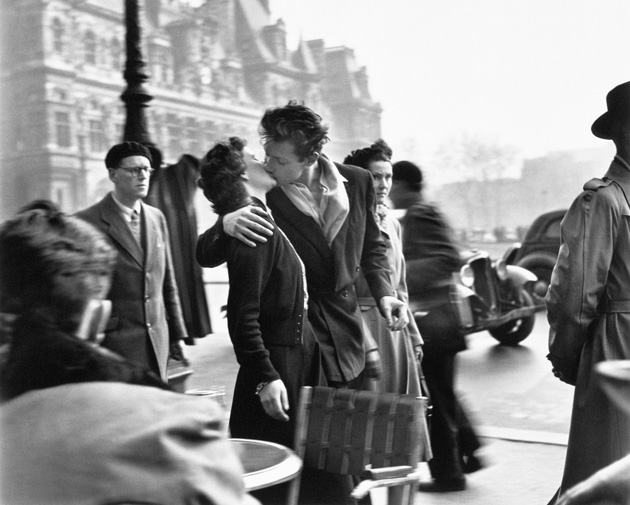The Exhibition: Robert Doisneau as told by the daughters of this great photographer
The exhibition is curated by Atelier Robert Doisneau and is based on original prints from Doisneau’s collection. It is an ambitious project by Francine Deroudille and Annette Doisneau – the daughters of this great photographer – who have selected the images for the exhibition out of their father’s body of work. A narrative embracing the art and life of Robert Doisneau is developed with over 140 black and white and colour shots.
The Sections of “Un certain Robert Doisneau” Exhibition
The exhibition opens with an introductory section, Robert Doisneau, presenting the biography of this great photographer, also illustrated with a series of photos from his family album, from the year of his birth to his 1985 portrait in his Montrouge studio.
The next section, Paris, is dedicated to the French capital, its squares, buildings and in particular the banlieue where Doisneau was born and grew up, documenting the city’s profound changes, from the tragedies of the war to the 1980s. This section includes some colour photos and the series of photos of the Petites boutiques systematically photographed by Doisneau in his neighbourhood in the 1960s.
Read more
The following section, the largest in the exhibition, is dedicated to Les parisiens, tothe Parisian people at work or celebrating, in the boulevards or bistrots, in the grey suburbs and small shops, in the doorways of buildings or in night clubs, captured mainly in their happiest moments, or while merely waiting.
There is also a series of photographs dedicated to Les enfants, testifying to the special attention Doisneau dedicated to children throughout his life. Of these solitary or rebellious children, he would often capture moments of freedom and play without the control of their parents. With the Vogue section, visitors are introduced to worldly events, of whichDoisneau captures their sophistication as well as, often, their futility. The exhibition ends with a series of portraits dedicated to the Célebrités of Paris in his time, and with whom he had established deep friendships: from Alberto Giacometti to Sabine Azéma, from Blaise Cendrars to Colette, from Jacques Prévert to Simone de Beauvoir, from Fernand Léger to Georges Braque, from Jean Cocteau to Pablo Picasso.
Biography of Robert Doisneau
Robert Doisneau was born in Gentilly, a suburb of Paris, in 1912. As a young man he studied lithography at the Ecole Estienne. However, he used to say that the streets of the working-class suburbs where he had grown up had taught him the most important lessons.
In 1929, he began to take up photography, working for the advertising photographer André Vigneau before moving on to work as an industrial photographer for Renault in the early 1930s. By this time, he began photographing the Parisian suburbs with the aim of selling his shots to photography magazines that were then starting to become popular. With the outbreak of the Second World War, Doisneau temporarily stopped his activities as a photographer and joined the Resistance, using his skills as a lithographer to forge documents.
Once the war was over, he started taking photographs again for advertising purposes and also produced some reportages for “Vogue”. In 1949, he published his first book of photographs La Banlieue de Paris. This was the first of a long series of books with images of Paris and Parisians. In the 1950s, he became a member of ‘Group XV’, an association of photographers dedicated to technical and artistic photographic research.
Thanks to Maurice Baquet’s insistence, in 1957 he made a very important trip to the United States, making several photographic reportages in New York and Hollywood, but above all in Palm Springs, where he was impressed by the artificial nature of the city, which he captured in great detail using colour films.
Read more
In 1966, he went to Canada for a reportage of Montréal and spent a few days in New York.
In 1967, he made another very important trip to the Soviet Union, where he shot a reportage entitled 50 Years of Soviet Achievements. In 1971, he toured French regional museums with Jacques Dubois. In 1973, Doisneau’s photographs were featured in a film by François Porcile entitled Le Paris de Robert Doisneau. In 1975 he was invited to the Rencontres d’Arles.
Despite his professional success, Doisneau was a caring husband and very attentive to his daughters and grandchildren who would often brighten the time he would spend with his family. In 1981, the film Poète et piéton by François Porcile was devoted to him. In 1982, two important exhibitions in New York and Lyon were held about his work.
In 1983, he was awarded the Grand Prix national de la photographie. In 1984, he participated in the Datar Photographic Mission, a public committee dedicated to the French landscape. Doisneau’s name is by now in photography textbooks. In 1986 he was awarded the prestigious Balzac Prize.
In 1992, he participated in the film Bonjour, Monsieur Doisneau, directed by Sabine Azéma and in 1993 Patrick Cazals shot the film Doisneau des Villes, Doisneau des Champs. That same year, however, he had a heart attack, and his beloved wife Pierrette passed away. Robert Doisneau died in Paris on 1 April 1994 and was buried next to his wife in the village of Raizeux, where they had met.


